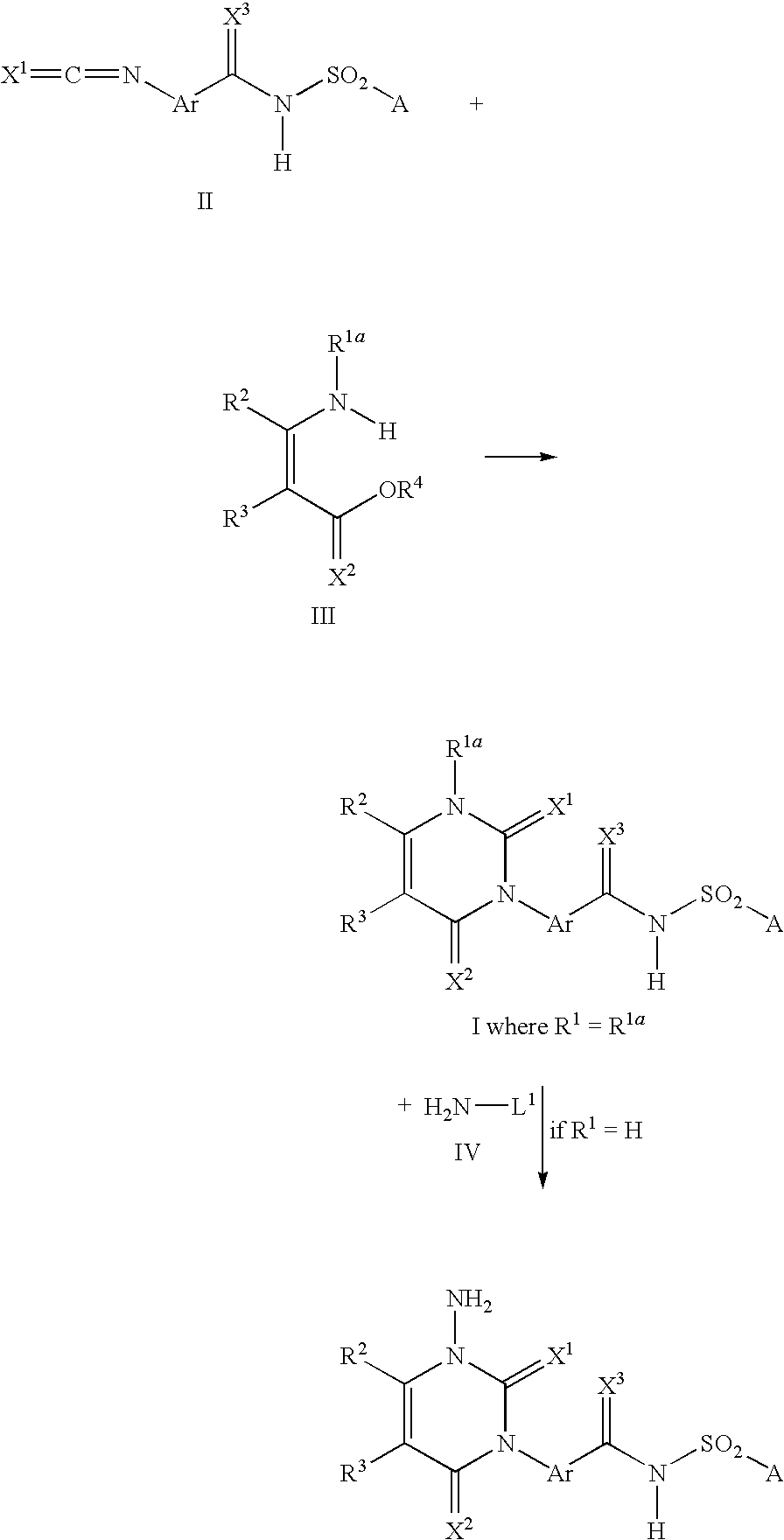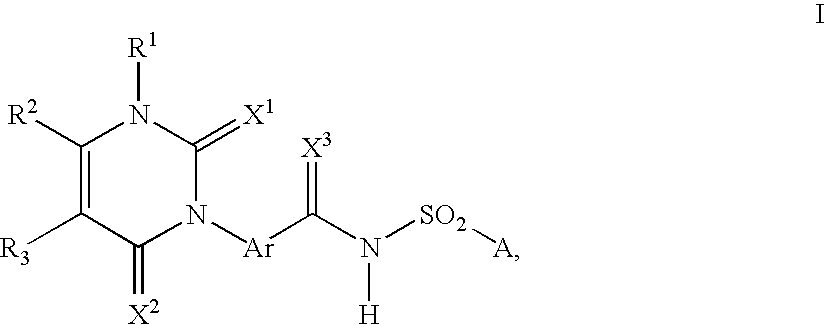Method for producing 3-phenyl(thio)uracils and 3-phenyldithiouracils
- Summary
- Abstract
- Description
- Claims
- Application Information
AI Technical Summary
Benefits of technology
Problems solved by technology
Method used
Image
Examples
example 1
Preparation of 2-chloro-5-[3,6-dihydro-2,6-dioxo-4-(trifluoromethyl)-1(2H)-pyrimidinyl]-4-fluoro-N-[[methyl(1-methylethyl)amino]sulfonyl]benzamide Using Sodium Hydride as a Base
[0196]
[0197]Under nitrogen, a mixture of 1.70 g (9.29 mmol) of ethyl 3-amino-4,4,4-trifluoro-crotonate in 20 ml of N,N-dimethylformamide and 20 ml of n-hexane is stirred under reflux on a water separator for 40 minutes. Afterward, the n-hexane was removed under reduced pressure, the remaining mixture was cooled to from 5 to 8° C. and 0.8 g (20 mmol) of 60% sodium hydride (in mineral oil) was added in 5 portions with stirring. After stirring for a further 15 minutes, a solution of 2.8 g (8.0 mmol) of N-(2-chloro-4-fluoro-5-isocyanatobenzoyl)-N′-methyl-(1-methylethyl)sulfamide in 10 ml of tetrahydrofuran was added with stirring to the yellowish solution and stirring was continued for 2 hours, ultimately at 22° C.
[0198]The reaction mixture was admixed with stirring with 2.0 g (33 mmol) of glacial acetic acid and...
example 2
Preparation of 2-chloro-5-[3,6-dihydro-2,6-dioxo-4-(trifluoromethyl)-1(2H)-pyrimidinyl]-4-fluoro-N-[[methyl(1-methylethyl)amino]sulfonyl]benzamide Using Potassium Methoxide as a Base
[0200]In the manner described in example 1, 1.70 g (9.29 mmol) of ethyl 3-amino-4,4,4-trifluorocrotonate in 20 ml of N,N-dimethylformamide were treated with n-hexane. Afterward, the remaining mixture was cooled to −12° C. and 1.47 g (19.9 mmol) of 95% potassium methoxide were added in one portion with stirring. The mixture was stirred at −15° C. for 15 minutes. A solution of 2.8 g (8.0 mmol) of N-(2-chloro-4-fluoro-5-isocyanatobenzoyl)-N′-methyl-(1-methylethyl)sulfamide in 10 ml of tetrahydrofuran was added to the yellowish solution at from −10° C. to −15° C. with stirring within 10 minutes and the mixture was stirred at from −10° C. to −12° C. for 3 hours. The reaction mixture was investigated by thin-film chromatography and it was found that there had been no change in the composition of the reaction m...
example 3
Preparation of 2-chloro-5-[3,6-dihydro-2,6-dioxo-4-(trifluoromethyl)-1(2H)-pyrimidinyl]-4-fluoro-N-[[methyl(1-methylethyl)amino]sulfonyl]benzamide; Process Using Potassium Carbonate as a Base
[0202]Under nitrogen, a mixture of 3.3 g (23.8 mmol) of potassium carbonate in 20 ml of N,N-dimethylformamide and 25 ml of n-hexane was heated to reflux at an internal temperature of 70° C. on a water separator with stirring for 30 minutes. The mixture was allowed to cool to 40° C. under nitrogen and then 1.7 g (9.29 mmol) of ethyl 3-amino-4,4,4-trifluorocrotonate were added, the mixture was heated to reflux for a further 30 minutes and then the n-hexane was removed under reduced pressure. With stirring, 2.8 g (8.0 mmol) of N-(2-chloro-4-fluoro-5-isocyanatobenzoyl)-N′-methyl-(1-methyl-ethyl)sulfamide in 10 ml of tetrahydrofuran were added to the resulting slightly reddish mixture which had been cooled to 22° C., and the mixture was stirred at 22° C. for 30 minutes and then at from 50 to 55° C. f...
PUM
 Login to View More
Login to View More Abstract
Description
Claims
Application Information
 Login to View More
Login to View More - R&D
- Intellectual Property
- Life Sciences
- Materials
- Tech Scout
- Unparalleled Data Quality
- Higher Quality Content
- 60% Fewer Hallucinations
Browse by: Latest US Patents, China's latest patents, Technical Efficacy Thesaurus, Application Domain, Technology Topic, Popular Technical Reports.
© 2025 PatSnap. All rights reserved.Legal|Privacy policy|Modern Slavery Act Transparency Statement|Sitemap|About US| Contact US: help@patsnap.com



